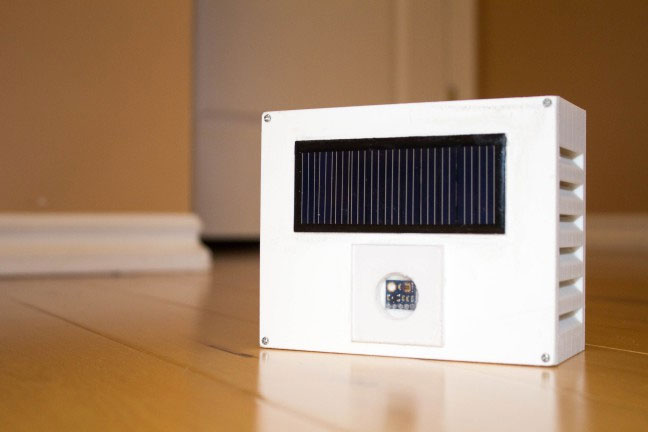Bob Dylan may not have needed a weatherman to tell him when the wind blows, but the rest of us rely on weather forecasts. These, in turn, rely on data from weather stations, and [Vlad] decided that his old weather station was in need of an upgrade.
His station, which uploads live data to the Weather Underground, needed to be solar-powered, weather-proof and easy to install. He seems to have succeed admirably with this upgrade, which is built around an ATmega328 and the 433 MHz link from the old station. As part of the upgrade, he built a 3D-printed enclosure and installed all-new sensors on a home-made PCB that are more accurate than the old ones.
He looked into upgrading the wireless leg to WiFi, but found that the school’s WiFi had a login page that he couldn’t get around. So he re-used the old 433 MHz radio and connected the other end of the link to an old laptop on the wired network. Good enough, we say. Now how about a snazzy display to go along with it?

















Nice project, I like weather-resistant coating and self-powering. My experience with DHT22/AM2302 modules are not so shiny, the best way to test this is to make little project on breadboard with 2,3,4 or 5 … modules next to each other and display values from all of them on small display. Temperatures are pretty OK, but humidity varies more than worst case in datasheet. So it’s question do you really want to have weather station that says it’s 80% humidity when it’s 90%.
BMP180 is nice module, Bosch don’t mess up with their datasheets so you can trust the number stated there.
However, I found one module (breakout for hard-to-solder package) that solves most of my problems. It’s BME280, also Bosch’s chip, some kind of successor to BMP180. It measures temperatrue, humidity and air pressure. All important data for weather station. It supports I2C and SPI, and it is easy to use even for those who don’t read datasheet and write their interface code, Adafruit already done that for you.
Agreed, I made the same experiment with DHTxx/AMxxxxx and reached the same conclusion. Later changed to the BMP180 / BME280 and been happy , both with accuracy and the fact that use i2c, instead of the proprietary bit-bang protocol of the DHTs. Have a few around the house connected to ESPs sending data to a server and a small SPI display to display locally. Someone mentioned in this forum that the reason the DHT might have that problem is that they would need to be recalibrated (even the BMx according to the datasheet after reflow).
Dylan didn’t need a weather man to know when the wind blew, nor did he need one to know ‘which way’ it blew.
I wonder if he could Wireshark out a solution to that login page? Enjoyable read though, it was well written.
No need to Wireshark it, check the link “PWS API” on his writeup, you can form URL in such way it accepts user, password and all weather data.
So with ESP module on the receiver side this station can be completely computer-free, assuming WiFi AP is present. Maybe an idea for next version.
I am currently building a PWS for Wunderground since South Africa has few stations.
I started looking a few hours before this popped up lol.
Anyway, at the moment I am manually pasting a URL with my details to update the station.
Pretty easy to run from an ESP8266 – which is exactly what I will do as soon as I have all the parts.
The esp8266 can deal with login pages by using post requests, using the same data you would send by hand. The only caveat is to use a valid account, so you need to ask the school for one.
Maybe I’m too focused on the detail, but this weather station actually does not tell which way the wind blows – none of the onboard sensors is capable to do that… :(
And indeed the Weather Underground page for PoCo doesn’t show wind direction.
I’ve been playing with weather measuring experiments for some time, and I came to a conclusion that if you want to make station that measures temperature, humidity, pressure and light intensity (or UV factor) you can make it for less than fifty bucks. But if you want complete solution you require wind and rain measurements, and it isn’t simple to make required assembly with sensors. In fact it’s pretty complicated, at least if you want it to be accurate. So you end up with commercial wind+rain solutions that costs about hundred bucks or more. So the price of your station multiplies by three and sets you very near the entry level Davis stations that are very well manufactured and tested.
It is well known among the wx community that Davis loves their weather stations so much, that you have to pay a lot of money to get them to part with even one of them.
Here’s a solution for detecting wind direction. Build a weather vane and mount a magnetometer (semiconductor compass) on it to measure the wind direction relative to magnetic north.
Hint: “know which way the wind blows” is a metaphor.
A meteorological metaphor?
B^)
Hope he sprayed the board with some kind of conformal coating or at least a paint so that it survives more than 3 months.
Hot-glue on.. everything!